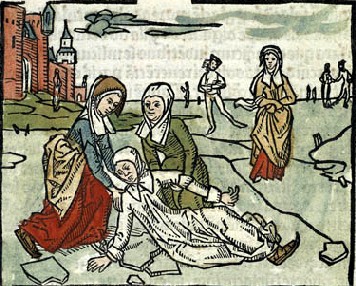History of Multiple Sclerosis - Cases
The History of Multiple Sclerosis Cases of People with MS
Who were the people associated with the history of multiple sclerosis? The case histories? There are several people throughout history who were thought to have MS.
How do we know?
Through early written accounts that describe their symptoms and life experiences. The journaled accounts of their lives sound so much like the signs and symptoms observed today in people with multiple sclerosis – so what else could they be but that?
One of the first cases we know about was of a woman named Halldora, who lived in Iceland around the year 1200. Her account tells how one day she suddenly lost her vision and mobility. She prayed to the saints and recovered them seven days later. That sounds suspiciously like relapsing-remitting MS.
Saint Lidwina of Schiedam (1380-1483)
Another woman, Saint Lidwina of Schiedam, is said to be the first person to have had MS and an integral part in the history of multiple sclerosis. She was a Dutch nun who suffered from the age of 16 until she died at the age of 53 with typical signs and symptoms of MS.
Lidwina had symptoms like intermittent pain, weakness of the legs, as well as vision loss, all common symptoms of multiple sclerosis. She also suffered from headaches, and had difficulty walking which eventually led to paralysis.
Over the course of her life, her health slowly got worse. She did, however, show clear signs where she would go into remission. Based on this, she most likely had a relapsing-remitting type of MS, that may have ended up as secondary-progressive.
There have been several accounts written of her life throughout the years. She was canonized on March 18 of 1890 by Leo XIII as the patron saint of ice skaters and also of the chronically ill. She is also known as the patron saint of the town of Schiedam.
Below you will find her prayer.
Augustus Frederick d'Este (1794-1884)
Another case that shows the history of multiple sclerosis unfolding was the grandson of George the III of the United Kingdom.
Augustus Frederick d'Este (1794-1848), was born on January 13th of 1794, the son of Prince Augustus Frederick who was the Duke of Sussex and his wife, Lady Augusta Murray. He was their only child. Augustus left behind a detailed diary describing his 22 years of living with the disease that was eventually diagnosed as what we know as multiple sclerosis today.
His first entry was made in 1822 when he was 28 years old and the last one was in 1846 when he would have been around the age of 52. His diary wasn't found until almost 100 years later in 1948.
Even though he wasn't diagnosed during his lifetime, his symptoms clearly point to multiple sclerosis. I'm sure if he'd had an MRI, we would have seen the telltale scars in his brain and spinal cord.
How do we know it's MS?
So why do historians and medical professionals feel that he had MS? What exactly were his signs and symptoms? First of all, they began with the sudden onset of visual loss after the funeral of a friend – his first diary entry. We know now that this is commonly one of the first symptoms that MSers experience.
He continued recording the following symptoms for the 22 years of his life that he is said to have had the disease. As you read through them, they sound like the same things that a typical MS patient complains of today.
- vision problems
- weakness of the legs
- clumsiness of the hands
- numbness
- dizziness
- bladder problems
- erectile dysfunction
- tremors
- nocturnal spasms
By the time he was 50, he could only get around by using a wheelchair. And in the very last years of his life, he was totally confined to his bed. In spite of having multiple sclerosis, he was said to be an optimistic person with a positive view of life.
I'm sure he was an inspiration to many of those who cared for him throughout his life. He died on December 28th in 1848. He never never married nor did he have any children, partly due to his birth being thought of as illegitimate. His parents were married, twice, in fact, however, their marriage was not recognized by the Crown.
He served in the army and rose in the ranks to colonel. He continued to be active in many ways, even serving as a member of the Aborigines Protection Society who advocated for the rights of Native Americans to own land in Upper Canada.
Like many people with MS, he was active during his early life and then developed it at the prime of his life. This follows a similar trajectory of MSers today. You can read more and see a picture of his diary on this site - Royal College of Physicians.
There's more! Click here to read about Bruce Cummings, another historical case of multiple sclerosis.
| History of Multiple Sclerosis - Part 1 | Part 2 | Part 3 | History of MS - Cases Part 1 | Cases Part 2 |
Dear Friends,
"Life in Spite of MS is a participant in the Amazon Services LLC Associates Program, an affiliate advertising program designed to provide a means for sites to earn advertising fees by advertising and linking to Amazon.com. We're also part of the Ebay Partner Network, another affiliate program."
We'd also like you to know it doesn't cost one cent more when you click through the links here on our blog. Not one single penny. And we will make a little extra cash when you do click through. We'll be ever so appreciative. You also have our word that we'll only link to things that we would use ourselves, (or wish we could have or use).
Sincerely,
Cir & Akrista
You are reading original content written by Akrista or Cir L'Bert of Life in Spite of MS. If you enjoyed reading this blog, please consider following us on Facebook, Twitter, Pinterest, and Instagram. See you there!
Privacy Policy ~ Advertising Policy ~ Disclaimer ~ Contact Us ~ About Us




New! Comments
Have your say about what you just read! Leave me a comment in the box below.